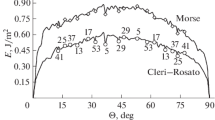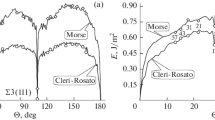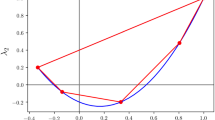Abstract
Orientation relationships of grains in tricrystals are discussed. Disorientation angles among grains are evaluated and a constrained condition of these around a triple junction is shown. Probability densities of the disorientation angles are obtained for randomly oriented grains by numerical calculations. A disorientation-angle diagram for tricrystal is proposed to characterize the orientation relationships of grains around the triple junctions.











Similar content being viewed by others
References
Mackenzie JK, Thomson MJ (1957) Some statistics associated with the random disorientation of cubes. Biometrika 44:205–210
Mackenzie JK (1958) Second paper on statistics associated with the random disorientation of cubes. Biometrika 45:229–240
Handscomb DC (1958) On the random disorientation of two cubes. Can J Mat 10:85–88
Field DP, Sanchez JE, Besser PR, Dingley DJ (1997) Analysis of grain-boundary structure in Al-Cu interconnects. J Appl Phys 82:2383–2392
West DA, Adams BL (1997) Analysis of orientation clustering in a directionally solidified nickel-based ingot. Metall Mater Trans A 28:229–236
Randle V, Davies H, Cross I (2001) Grain boundary misorientation distributions. Curr Opin Solid State Mater Sci 5:3–8
Humphreys FJ (2001) Review: grain and subgrain characterisation by electron backscatter diffraction. J Mat Sci 36:3833–3854
Randle V (1994) Grain assemblage in polycrystals. Acta Metall Mat 42:1769–1784
King AH (2010) Triple lines in materials science and engineering. Scripta Mater 62:889–893
Okada T, Onaka S, Hashimoto S, Miura S (1989) Suppression of grain-boundary sliding by a boundary node in Cu-9at.%Al tricrystals. Scripta Metall 23:49–54
Onaka S, Tajima F, Hashimoto S, Miura S (1995) Retardation of intergranular fracture at intermediate temperatures by a boundary node in a Cu-9at.%Al alloy tricrystal. Acta Metall Mater 43:307–311
Okada T, Hisazawa H, Iwasaki A, Amimoto S, Miyaji J, Shisawa S, Ueki T (2019) Grain-boundary sliding and its accommodation at triple junctions in aluminum and copper tricrystals. Mater Trans 60:86–92
Okada T, Hisazawa H, Iwasaki A, Kawaguchi K, Morimoto H, Nakano K, Ueki T, Tomita T (2021) Creep fracture of aluminum and copper tricrystals having < 110 >-Tilt Σ 3, 3, 9 grain boundaries. Mater Trans 62:239–245
Frary M, Schuh CA (2003) Combination rule for deviant CSL Grain boundaries at triple junctions. Acta Mater 51:3731–3743
Priester L (2013) Grain Boundaries, From Theory to Engineering. Springer Series in Materials Science 172, ISBN 978–94–007–4969–6 (eBook) 398–402
Onaka S (2020) Arrangements of three to six cubes with maximum disorientation angles. Phil Mag 86:1703–1715
Frary M, Schuh CA (2004) Percolation and statistical properties of low- and high-angle interface networks in polycrystalline ensembles. Phys Rev B 69:134115
Morawiec A (2004) Orientations and rotations. Springer, New York
Hayashi K, Osada M, Kurosu Y, Onaka S (2016) Log Angles: characteristic angles of crystal orientation given by the logarithm of rotation matrix. Mater Trans 57:507–512
Acknowledgements
This work was supported by JSPS KAKENHI Grant Number 19K04985.
Author information
Authors and Affiliations
Corresponding author
Ethics declarations
Conflict of interest
The authors declare that there is no conflict of interests regarding the publication of this paper.
Additional information
Handling Editor: N. Ravishankar.
Publisher's Note
Springer Nature remains neutral with regard to jurisdictional claims in published maps and institutional affiliations.
Appendix
Appendix
A grain orientation can be describe by using a rotation matrix \({\varvec{T}}\) with respect to a reference coordinate system. This \({\varvec{T}}\) is a 3 × 3 orthogonal matrix whose determinant is 1. Any orientation is expressed by a product of appropriate three rotation matrices which cause rotations around the coordinate axes. Three rotation angles around the coordinate axes are called the Euler angles. The rotation matrix \({\varvec{T}}\) with the three the Euler angles \(0\le {\theta }_{\text{e}}\le \pi\), \(0\le {\phi }_{\text{e}}<2\pi\) and \(0\le {\psi }_{\text{e}}<2\pi\) given by the following equation is an example of the rotation matrix giving any orientation:
Describing the Euler angles \({\theta }_{\text{e}}\), \({\phi }_{\text{e}}\) and \({\psi }_{\text{e}}\) as a function of random numbers appropriately, we can obtain \({\varvec{T}}\) giving random orientations. When \({M}_{i}\left(i=\mathrm{1,2} or 3\right)\) are random numbers in the range of 0 to 1 with uniform distribution over that range, Eq. (11) with the Euler angles given by
and
can generate three dimensionally random orientations with uniform distribution. Note that \({\theta }_{\text{e}}\) is not proportional to \({M}_{1}\). The reason is that the probability density \(\rho \left({\theta }_{\text{e}}\right)\) of \({\theta }_{\text{e}}\) to generate the random orientations is proportional to \(\mathrm{sin}{\theta }_{\text{e}}\) [18]. The inverse cosine function in the right-hand-side of Eq. (12a) comes from \(d\mathrm{sin}{\theta }_{\text{e}}/d{\theta }_{\mathrm{e}}=\mathrm{cos}{\theta }_{\mathrm{e}}\).
To obtain the disorientation angle \(\theta\) between cubic grains, it is necessary to include the crystal symmetry. Here, we explain the procedure by considering two cubic Grains 1 and 2. When orientations of Grains 1 and 2 are given by the rotation matrices \({{\varvec{T}}}_{1}\) and \({{\varvec{T}}}_{2}\) with respect to a reference coordinate system, respectively, the rotation matrix \({{\varvec{R}}}_{12}\) from Grains 1 to 2 described by using the frame of Grain 1 is written as [19]
where \({{\varvec{T}}}_{1}^{\mathrm{T}}\) is the transpose of \({{\varvec{T}}}_{1}\). The cubic structure is invariant under 24 proper symmetrical rotations and these are (a) identity element or no rotation, (b) rotations of \(90^\circ\), \(180^\circ\) or \(270^\circ\) about the three < 100 > axes, (c) rotations of \(180^\circ\) about the six < 110 > axes and (d) rotations of \(120^\circ\) or \(240^\circ\) about the four < 111 > axes [2]. Writing \({{\varvec{S}}}_{\text{i}}\) (i = 1, 2, …, 24) as the matrix representations of these symmetrical rotations, the disorientation angle \({\theta }_{12}\) between Grains 1 and 2 is w
where \({\text{Tr}}\left({{\varvec{R}}}_{12}\boldsymbol{ }{{\varvec{S}}}_{\text{i}}\right)\) is the trace of the matrix \({{\varvec{R}}}_{12}\boldsymbol{ }{{\varvec{S}}}_{\text{i}}\).
Rights and permissions
About this article
Cite this article
Yoshimasu, F., Miyazawa, N., Nakada, N. et al. Probability densities of disorientation angles among randomly oriented grains in tricrystals. J Mater Sci 57, 3010–3017 (2022). https://doi.org/10.1007/s10853-021-06729-w
Received:
Accepted:
Published:
Issue Date:
DOI: https://doi.org/10.1007/s10853-021-06729-w




